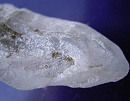
|
| Gaylussite |
Chemical
Formula |
Na2Ca(CO3)2·5H2O |
Species |
Carbonates |
Crystal
System |
Monoclinic |
Mohs
Scale |
2 |
Specific
Gravity |
1.93-1.99 |
Color |
Colorless, white, yellow, and grey |
Streak |
white |
Luster |
Vitreous |
Refractive
Index |
n = 1.444 n = 1.516 n = 1.523 |
Diaphaneity |
Transparent, Translucent |
Cleavage |
PerfectOn perfect; rather difficult. |
Fracture |
Conchoidal |
| Crystal Habit:Tabular prismatic crystals also granular |
| Geological Setting:Soda lakes. |
Gaylussite is a carbonate mineral, a hydrated sodium calcium carbonate, formula Na
2Ca(CO
3)
2·5H
2O. It occurs as translucent, vitreous white to grey to yellow monoclinic prismatic crystals. It is an unstable mineral which dehydrates in dry air and decomposes in water.
It is formed as an evaporite from alkali lacustrine waters. It also occurs rarely as veinlets in alkalic igneous rocks.
It was first described in 1826 for an occurrence in Lagunilla, Mérida, Venezuela. It was named for French chemist Joseph Louis Gay-Lussac (1778-1850).


 YueGongAnBei 44051102000467
YueGongAnBei 44051102000467